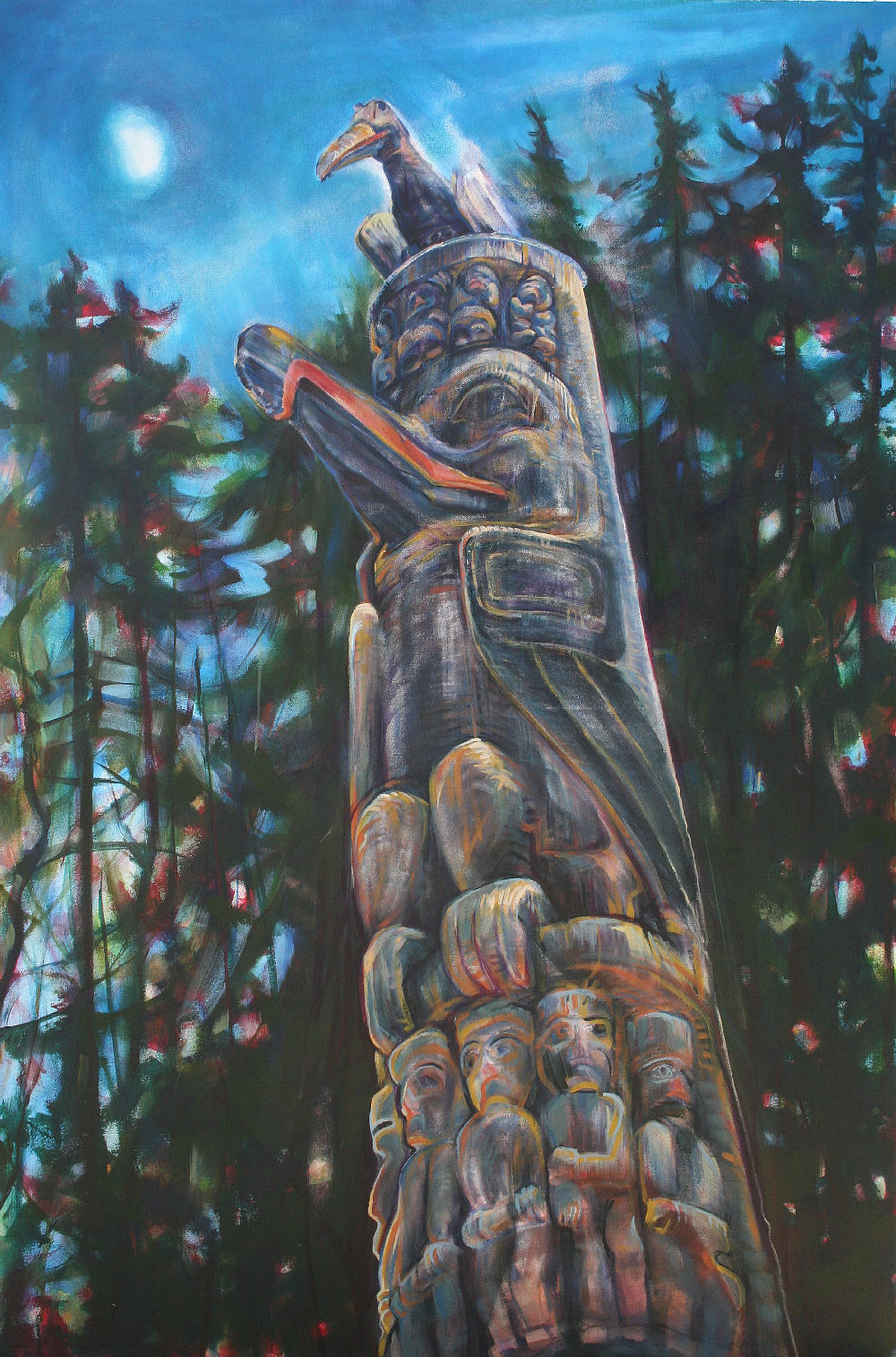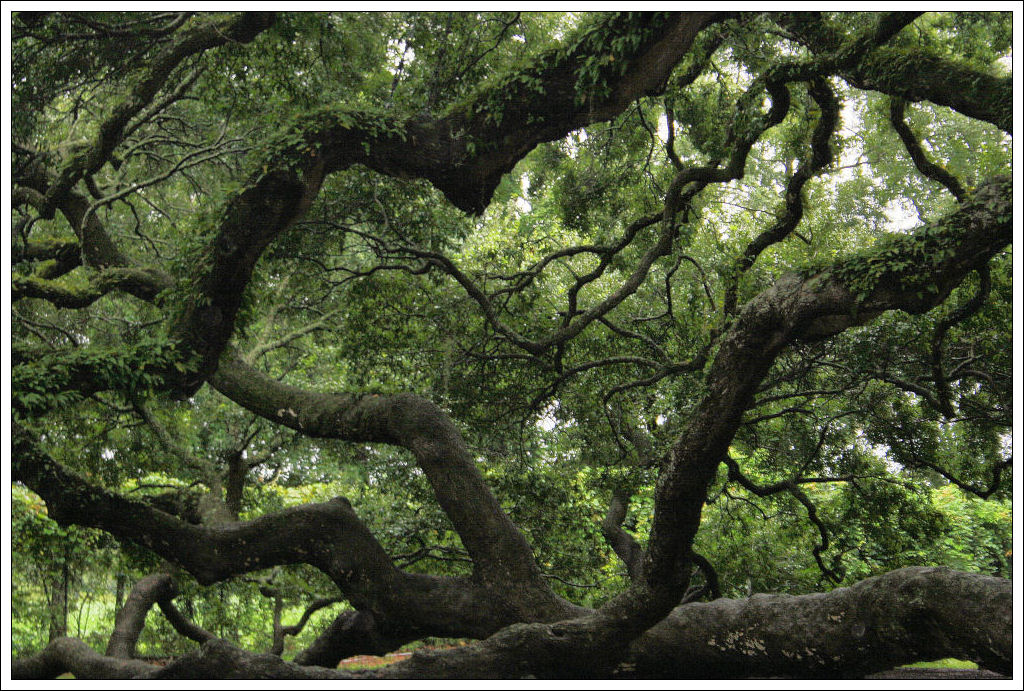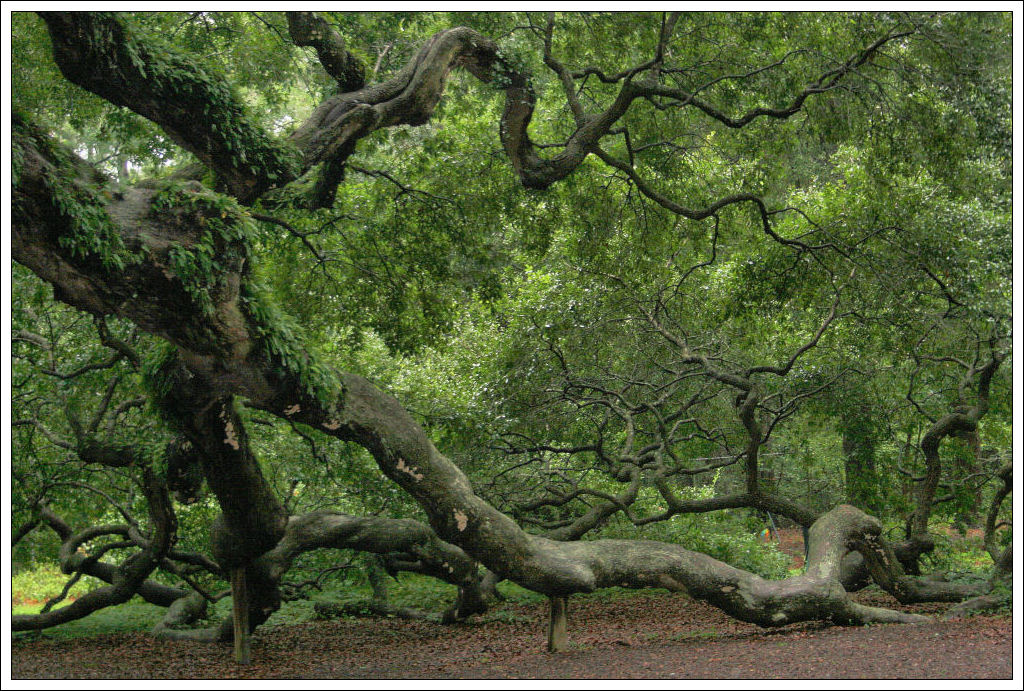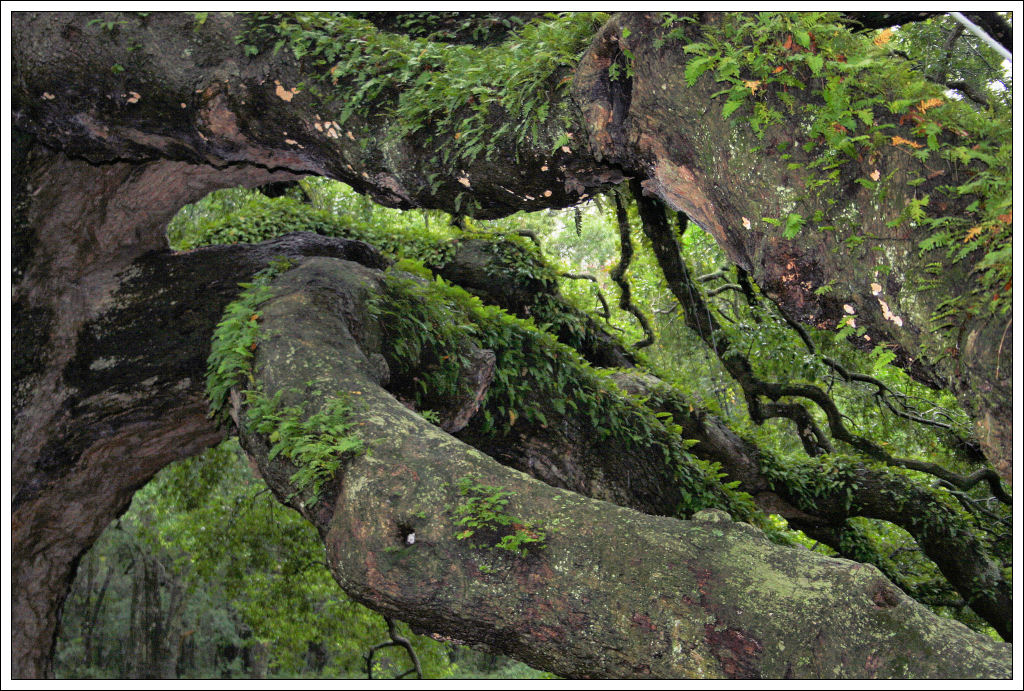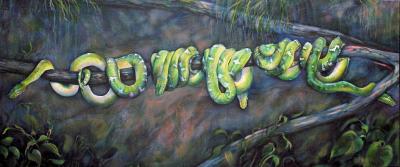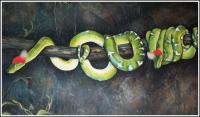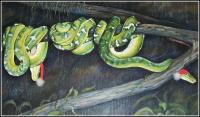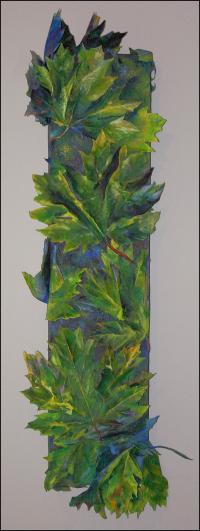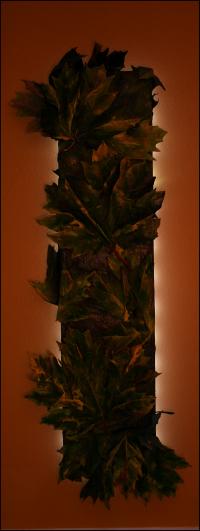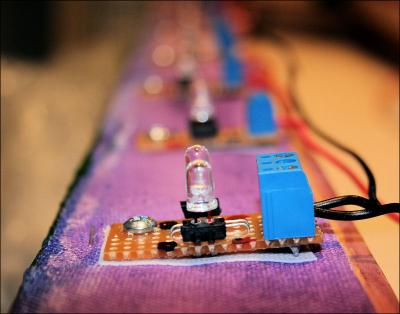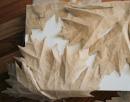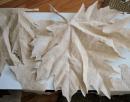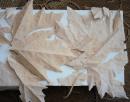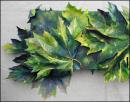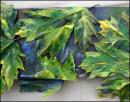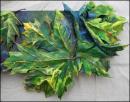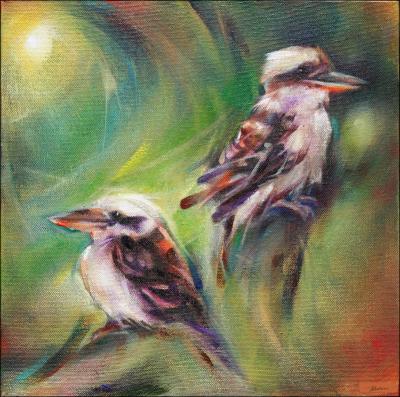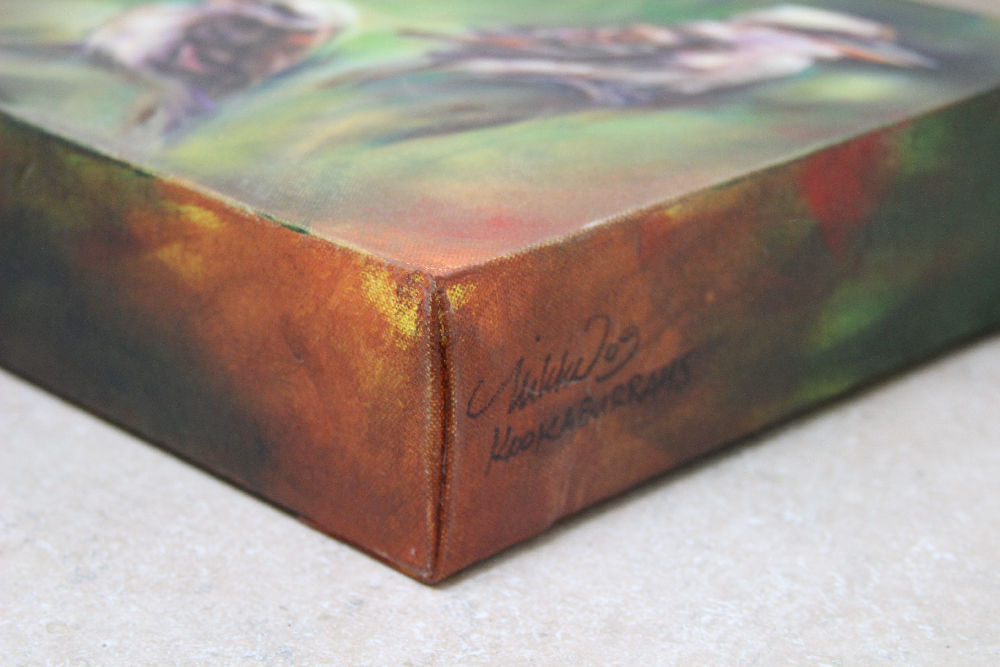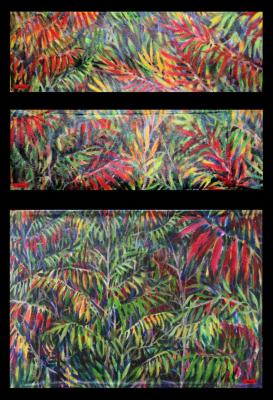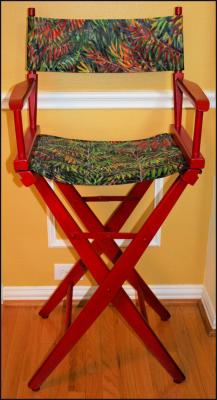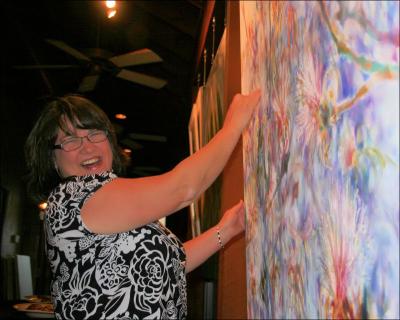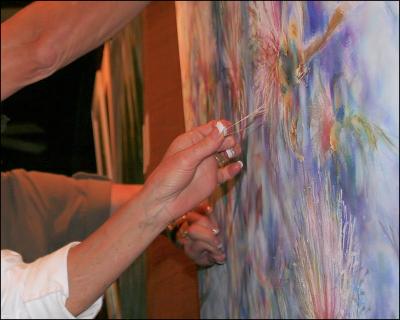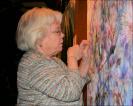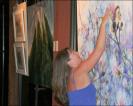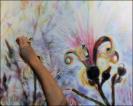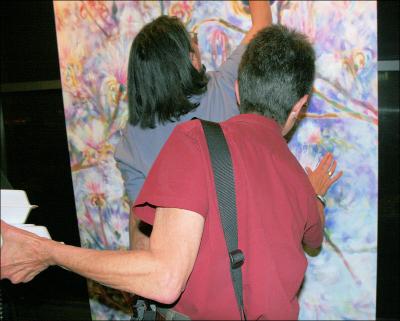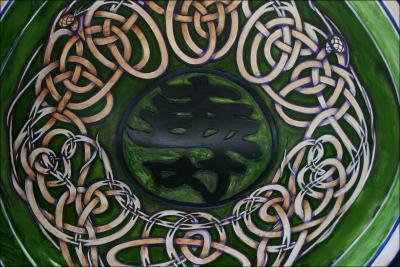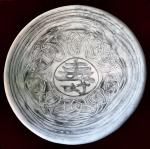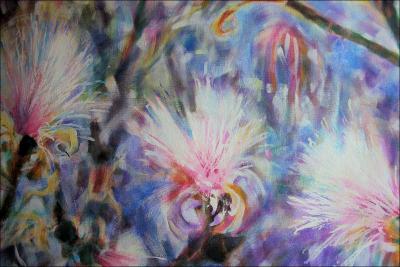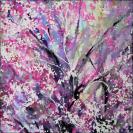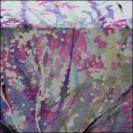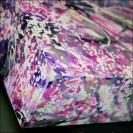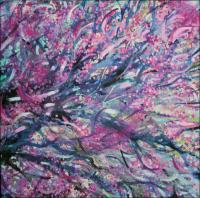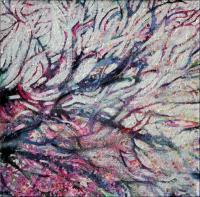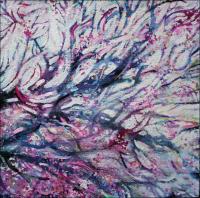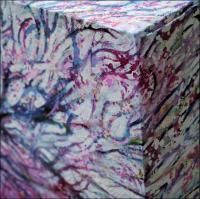The Majesty of Trees Collection
« Previous EntriesSigns and Symbols
Wednesday, January 10th, 2024
Showing in Gallerium Art’s Signs and Symbols January 10 – March 10, 2024: Magic Hour (Gitxsan Totem Pole, Thunderbird Park, Victoria, BC Canada), 60H x 40W x 3D inches acrylics on canvas. Wrapped sides painted, sturdy home-built stretcher frame, navy blue narrow wood trim finishes the sides.
The Angel Oak, South Carolina
Saturday, April 14th, 2018
This article and set of photos, initially written in 2008 and updated in 2018, honors the tireless efforts to halt construction on John’s Island, South Carolina that would have encroached on an area of land boasting the Oak tree estimated to be 400 to 500 years old. Thanks to conservation and other local groups like schools and churches, individual donors, pro-bono work from lawyers, a sizable grant, and numerous petitions, we are reassured that persistence does make a difference on this planet. The land surrounding the Angel Oak is no longer in jeopardy. Read more about this amazing tree.
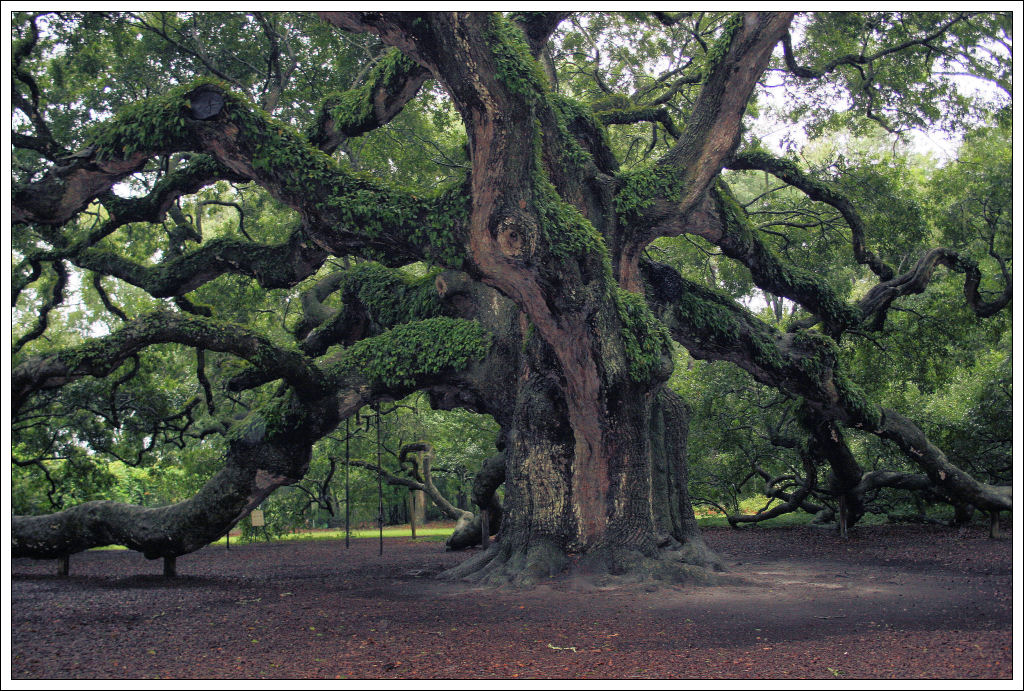 Charleston, SC is proud of its heritage and respected for its commitment to preserving history in the area, and after many years, residents were finally victorious over plans that would have cut down nearby trees and forest in favor of land development.
Charleston, SC is proud of its heritage and respected for its commitment to preserving history in the area, and after many years, residents were finally victorious over plans that would have cut down nearby trees and forest in favor of land development.
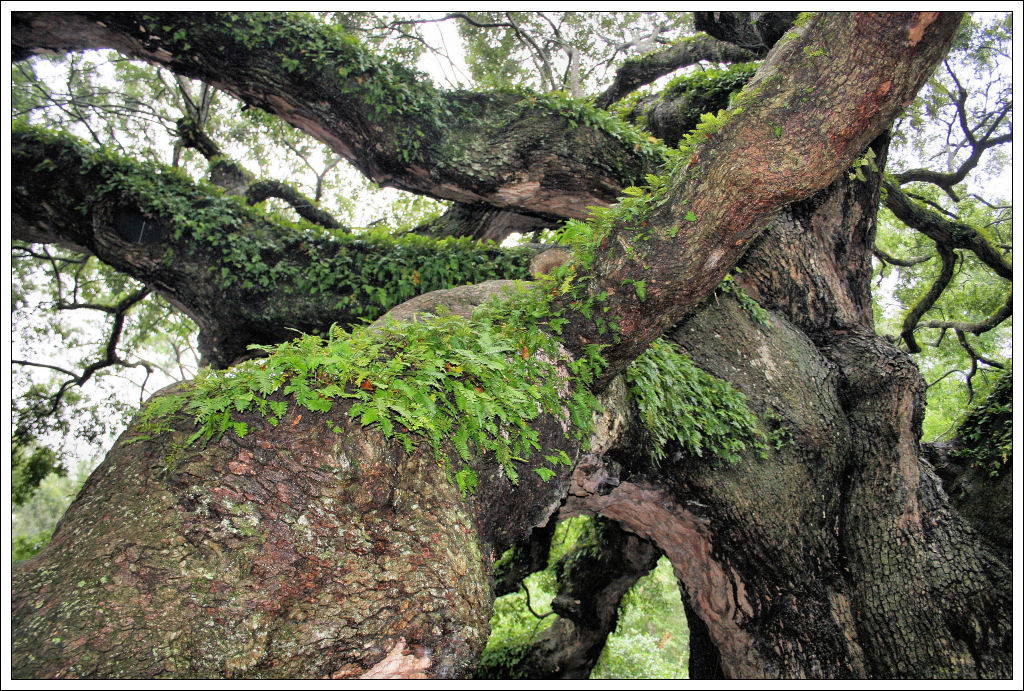 In one 2008 online petition there were hundreds of pages of interesting comments and pleas from residents who have fond memories of climbing the branches as children, plus exclamations written by tourists – national and international – who have visited the area specifically to see the Angel Oak. The tree is so significant to locals, a nearby elementary school carries its name. Picnics, weddings and reunions are held in the Angel Oak Park, including an annual summer Arts event, “Evening under Angel Oak” featuring live music, drama and other activities.
In one 2008 online petition there were hundreds of pages of interesting comments and pleas from residents who have fond memories of climbing the branches as children, plus exclamations written by tourists – national and international – who have visited the area specifically to see the Angel Oak. The tree is so significant to locals, a nearby elementary school carries its name. Picnics, weddings and reunions are held in the Angel Oak Park, including an annual summer Arts event, “Evening under Angel Oak” featuring live music, drama and other activities.
 During August, 2008 my husband and I drove through South Carolina and took a short detour to John’s Island. We drove through wicked rains at the edge of Tropical storm Faye, so when we arrived at Angel Oak Park no one else was there. Although the light was not ideal, fortunately rain subsided long enough to take photos.
During August, 2008 my husband and I drove through South Carolina and took a short detour to John’s Island. We drove through wicked rains at the edge of Tropical storm Faye, so when we arrived at Angel Oak Park no one else was there. Although the light was not ideal, fortunately rain subsided long enough to take photos.
This is one impressive tree! The trunk and lower branches are so immense, they have been propped up with stakes and heavy cables here and there, which is a little intrusive when taking photos, but obviously necessary. Growth is spread outward more than upward. No wonder it is considered sacred by the locals… there is an appreciable presence felt while standing silently under its canopy, which apparently occupies 2,000 yards of space above.
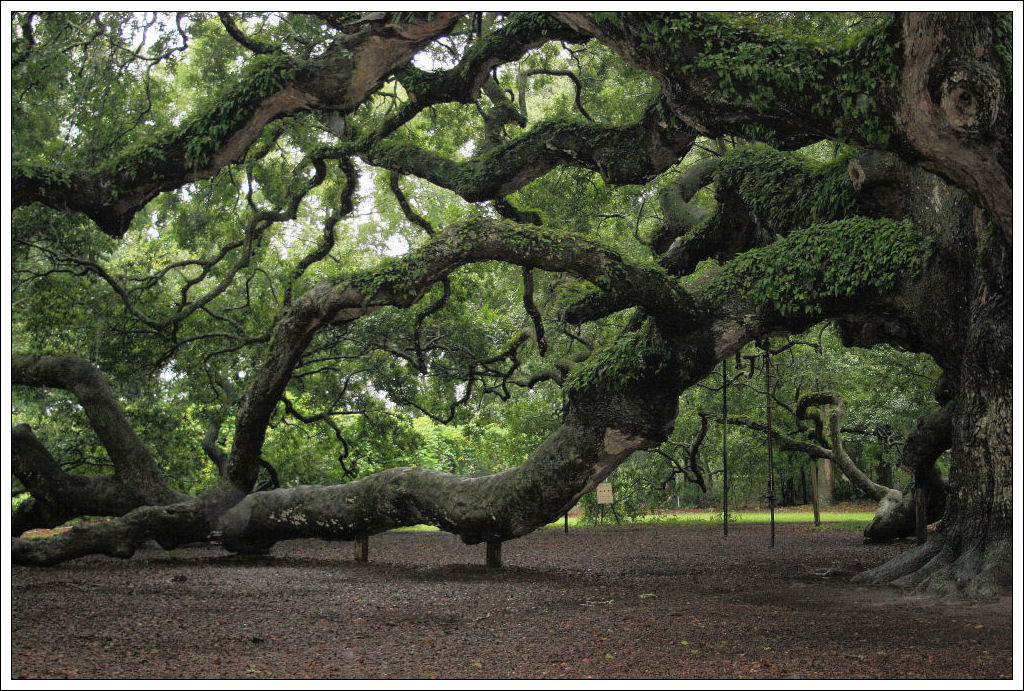 It occurred to me that this tree has lived through one serious chunk of history, and I wondered what was happening on our planet when it was knee-high to an acorn? The Angel Oak’s parent-tree and surrounding forest flourishes for eons before one special acorn falls from one of the magnificent Oaks on the southeastern shores of a land only known to the indigenous peoples then. The acorn sprouts along with many others, but this one will outlive the rest, seasoning hurricanes, climate changes, human encroachment and wars.
It occurred to me that this tree has lived through one serious chunk of history, and I wondered what was happening on our planet when it was knee-high to an acorn? The Angel Oak’s parent-tree and surrounding forest flourishes for eons before one special acorn falls from one of the magnificent Oaks on the southeastern shores of a land only known to the indigenous peoples then. The acorn sprouts along with many others, but this one will outlive the rest, seasoning hurricanes, climate changes, human encroachment and wars.
 Much of what we are familiar with; our collective modern identity has been shaped by the events and people who lived and died since the Angel Oak established its first roots in the earth. If trees could talk…!
Much of what we are familiar with; our collective modern identity has been shaped by the events and people who lived and died since the Angel Oak established its first roots in the earth. If trees could talk…!
The Angel Oak does not exist on its own. It depends on the surrounding forest, so any deliberate disturbance in the immediate soil or neighboring properties would disrupt its far-reaching and delicate root system. Thankfully, now the tree will remain host to a myriad of life forms, supporting an abundant, specialized ecosystem of mosses, fungi and fern varieties, insects and amphibians – hopefully for five hundred more years. The Angel oak lives on as one of the true jewels on this planet.
While older, poorer quality photos are still gradually being replaced, the Majesty of Trees / Dancing with Trees exhibition website is now updated. Check it out!
Perpetual painting
Monday, October 5th, 2009
Like music
where silence between the notes sets the rhythm,
not painting is half the work.
 For all artists, the most mysterious question of all might be “is it finished?” , but for the sake of clarity and the examples here I’ll just refer to painters. One popular opinion is that the best painting is one that’s finished quickly; one that retains the artist’s first fresh impressions, otherwise it should be painted over or tossed in the garbage and a new one started immediately. There are solid reasons for not lingering too long on a painting, but in matters of the Art I’m always suspicious when I hear the word should being used in a sentence containing advice. Some art rumors are accepted as absolute when they could stand some explanation. It can be confusing enough for the experienced, but especially for beginners looking for ground rules and a map to follow.
For all artists, the most mysterious question of all might be “is it finished?” , but for the sake of clarity and the examples here I’ll just refer to painters. One popular opinion is that the best painting is one that’s finished quickly; one that retains the artist’s first fresh impressions, otherwise it should be painted over or tossed in the garbage and a new one started immediately. There are solid reasons for not lingering too long on a painting, but in matters of the Art I’m always suspicious when I hear the word should being used in a sentence containing advice. Some art rumors are accepted as absolute when they could stand some explanation. It can be confusing enough for the experienced, but especially for beginners looking for ground rules and a map to follow.
In Art though, for every should there is another option. The same suggestions don’t work for everyone. Have you ever felt guilty or embarrassed – even ashamed – because you took a painting too far? I have, but it’s only when I’ve compared my work and methods to others’ judgment that I should’ve quit while I was ahead…and guilt has no business hanging around in our daily work if it isn’t useful! Frustration can be an excellent motivator if it’s allowed to be.
If it’s going to make sense – not exclusively the sole intention – every painting reaches stages where we need to make the call to leave it alone and say it’s finished, or proceed; stages where placing one more mark means the entire painting has to change and be brought up to par around it. If things that need correcting are not dealt with honestly, the work will not be as successful as it could be. There are phases in each painting that are truly intimidating, when painting is anything but leisurely; when we’re faced with: do we climb that mountain or not?
A lot of Plein Aire artists swear that their methods of painting outdoors on-site produce the highest quality work. The limitations of sunlight, location, outdoor temperatures and so on, mean that to finish successfully they need to splash down a lot of information within a short period of time. Doing so, when the thinking brain is disengaged and just responding to the subject, a lot of amazing unintentional surprises show up in the painting. Spontaneity and spurts of enthusiasm for being fully in the present tense can bring great results that need no further efforts at the end of the day. Plein Aire artists are in a field of their own (literally too!).
It’s a curious thing how creativity warps and reforms into amazing things when pressure is applied. Many people who aren’t artists will agree that the greatest ideas can occur when under pressure to produce them. For those who have orders to complete, at its best the challenge is like a beautiful sort of panic, where there’s an understanding of the time restrictions while fully trusting that whatever needs to happen is going to be successful. The abilities are less trustworthy when the pace and demand for finished work increases, time allotted decreases and the quality of the product diminishes. If this imbalance continues over extended periods of time, like years, sloppy and care-less habits take hold too easily. If there is work that must be accomplished though, these things can be controlled to some extent –this is one benefit of pushing personal boundaries: it puts tenacity to practice – but creativity is fickle and that’s a fact.
What has all that got to do with the question about finishing? The best paintings are not necessarily those that are finished in a few hours or a day. There are other purposes for painting besides finishing it to admire, be admired or to sell. Nothing replenishes the quality of our creative energy like being lost in the timeless, pure enjoyment of study and detail for no reason in particular. “The Zone” is like an addiction where the high is fairly elusive but we’re compelled compulsively to track it down again and again, discovering and rediscovering the source of it all. One painting could be someone’s lifetime of work.
I’m saying that if you personally feel you’d like to keep going with a painting for days or years… or never finish, then you ought to follow your own intuition about it. I’m not saying you should. I just recommend considering what other artists say, but also consider each painting as a new experience with new rules, new goals and new circumstances.
Experience, masterpiece to failure, will always apply to future work somehow. That’s the great thing about painting: no time spent searching for answers is ever wasted. It’s all recyclable material! Every decision about finishing – or not – is relative to individuality, and relative to each new painting as it develops your way.
Pushing the boundaries
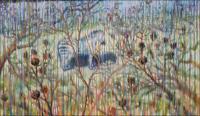 Myrtle At The Zoo, first version, Phase 18, unfinished – Crepe Myrtle branches and seedpods – 20 x 34 x 2 inches acrylics on canvas, gallery wrapped.
Myrtle At The Zoo, first version, Phase 18, unfinished – Crepe Myrtle branches and seedpods – 20 x 34 x 2 inches acrylics on canvas, gallery wrapped.
Work daily March 10th through April 2nd, 2008:
Finished for now…this one needs a rest, and I may or may not return to it. Regardless, I’ve learned a lot ad enjoyed playing with different ideas. It’s been interesting teetering back and forth between frustration and fun, but sometimes that’s what painting is all about. There’s been such a tension over this one as with no other painting, where the urge to throw it away is pitted against the determination to see what could happen. I still like a lot of things in it, such as the technique of dripping paint down the front that I’ve tried in previous paintings. Dripping re-energized the painting and me, and took the work in unexpected directions.
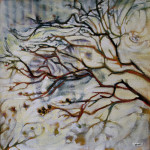 Myrtle At The Zoo, 2nd version – 11 x 11 x 3 inches acrylics on canvas, gallery wrapped sides painted. Many of the issues were worked through on the previous larger version, and I’m pleased with this boxy little painting…still not completely satisfied that I’m finished with this subject because it’s so complex, and it’s like a puzzle that’s nagging at me to figure out, so will probably attempt this same painting at least one more time.
Myrtle At The Zoo, 2nd version – 11 x 11 x 3 inches acrylics on canvas, gallery wrapped sides painted. Many of the issues were worked through on the previous larger version, and I’m pleased with this boxy little painting…still not completely satisfied that I’m finished with this subject because it’s so complex, and it’s like a puzzle that’s nagging at me to figure out, so will probably attempt this same painting at least one more time.
Perpetual painting
Painting animals with distinct and specific characteristics calls for a different approach from start to finish, for example, compared to generic landscapes. The boas are one of my favorite exhibits at the Dallas World Aquarium, downtown Dallas, Texas. The phosphorescent green skin has striking black and white scale patterns along the spine and a turquoise mother-of-pearl overall sheen that’s most visible at certain angles where the body delicately curls and bends, so this painting accumulates finer detail than is typical of my work, except in graphite illustrations.
Emerald Tree Boas, 24 x 57 x 2 inches acrylics on canvas, wrapped sides painted (August, 2005 – ? )
As shown in the thumbnail above, there are only a few small things left to do, a little on the skin then some barely visible brushstrokes in the background like ones that were there in earlier phases, thumbnail…so it really is just about finished, but I’m not in any hurry. Of course I’ll stop in my tracks if you want to buy it!
I like having one painting around that’s going to get the full treatment! Emerald Tree Boas has become like an old friend, even hanging out celebrating holidays in the dining room with the rest of us. It would be nice if this painting could carry enough potency to alter the automatic responses of fear and disgust that are associated with snakes. It just occurred to me that it might be fun to offer the buyer an assortment of hats and hearts and ribbons for different occasions. Where I used tape, instead I’d put magnets on the back and magnets on all the little hats and accessories. It’s a little nutty maybe, but it also opens up the target market a little doesn’t it!
Nature is perfectly imperfect. I paint with acrylics, so if the surface is washed back and scrubbed regularly in areas that need change. Scrubbing paint away with a pot scrubber or wet cloth used to remove paint helps texturize, give atmosphere, and also ensure that paint won’t cake up in areas, unless that’s the intention. More debates about spending too long on a painting are that it stiffens the whole look and feel because 1) it tidies things up too much, and 2) due to the plastic properties of acrylics, if they are allowed to pile up they will harden and shine, no longer catching the tooth of the canvas.
These are all things that can also be used to advantage though. In sports you need to know your opponent… well the same is true here. You can use the buildup to create the effects it produces if that’s what you want to achieve. To keep the canvas texture for as long as possible, paint diluted with gels or water is perfect to start, then as confidence builds, so can your applications of paint. My philosophy is that if things need to change they do, until the word “finished” is loud and clear.
…practice and even failure can be applied to future work…
What Bigleaf Maples Do At Night
Monday, May 25th, 2009
What Bigleaf Maples Do At Night, 57H x 20W x 4D inches muslin, glue, acrylics on canvas wrapped over custom-built stretcher frame. LED light system in back.
Alain, my husband, signed his name on this also, because he spent the entire week designing, soldering and wiring a system of 30 LED lights for the back. He was not impressed with the eight inadequate push-lights I was initially going to use to create this Day- Night Art. The electric source is a rechargeable 12 volt battery placed neatly in the back, with an easily accessible on-off switch in the lower left corner. He’s not thrilled to ever create another, so it looks like I’ll be learning a little about soldering and electronics, because there are plans to transform the other two canvases exactly the same size as this one. Originally l hoped it could hang in any of four orientations, but that was revised due the battery pack in the back. Thank you Alain for making this piece what it is!
______________________The original blog posts; process:___________________
Nov. 17th, 2008: While finishing the final stages of Sun Shower #4, at this point more study than stroke, I’ve started on the next piece… a bit of mystery thrown into this one just for fun. Hint: Step 1 – Unbleached muslin is painted with glue; place over top parchment paper and turn or lift frequently so it doesn’t stick. Nov. 18th: Step 2– When dry the muslin becomes stiff and can be crumpled, pinched and maneuvered to create 3D textures.
Nov 18th, aft. Step 3 – OK, enough guessing. I have three beautiful sturdy 36 x 12 x 3 inch canvases, hung vertically or horizontally. Each one will have a 3D design of life-sized leaves created with the stiff muslin. This one is of Large Leaf Maples seen on salt Spring Island, B.C. when we were there last summer. They are really this big – about 15 inches across! On these canvases, all dimensional surfaces will be considered; the front, the sides, and possibly some sticking out from the back. Everything will be primed before painting and I love Virginia’s idea to use glue as a resist for the leaf veins. In the above three images the design is still in planning stages.
Nov. 19th – A few thoughts before continuing work: this could be as simple as a sillhouette or painted realistically, still haven’t decided..maybe a compromise of the two, on the abstract side of things. Putting lights in the back could be interesting too, as in the recent Zen Garden #8 but would like to come up with something that does not have a distracting cord.
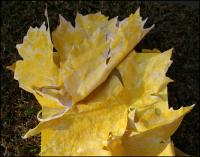 Nov.21st – Seen here, the leaves have a splotchy base coat of Hansa Yellow Deep, a color chosen because when it is so vibrant when it peeks through built up layers of other colors. Now that the entire piece has color though, I think I prefer the sculptural purity of the unpainted sillhouettes better – something to remember for similar work in the future.
Nov.21st – Seen here, the leaves have a splotchy base coat of Hansa Yellow Deep, a color chosen because when it is so vibrant when it peeks through built up layers of other colors. Now that the entire piece has color though, I think I prefer the sculptural purity of the unpainted sillhouettes better – something to remember for similar work in the future.
The weight of tinted primer and each application of acrylics makes the fabric limp from of the paint, meaning the creasing process needs to be done all over again once it dries, even on successive layers. Because of this I need to slow down and be more gentle with the painting process also. It’s funny how you can overlook things like that when you are ten steps ahead with anticipation for a new project; things always take much longer than you imagine. There is going to be a lot of stopping and starting with this one, which is exactly how overlapping projects occurs.
Also: looking forward to a day-long workshop tomorrow, learning about Encaustic painting with Deanna Wood. Encaustics is an ancient process of painting with beeswax and natural resins. Not usually a “workshop” kind of Artist because I’m too greedy with my work-time, but this is one of those things that’s best learned from an expert. Am bringing a fabric leaf to the class to see how it could be incorporated and if this entire. Large Leaf Maples piece could benefit.
______________________________
All posts and comments for this piece are now combined.
Submitted on 2008/11/18 at 11:48am
If you don’t want to see the seed bits in the muslin, you can get unbleached muslin without the seeds.
_______________________________
Submitted on 2008/11/18 at 1:03pm
OK Lynda, thanks for offering this valuable tip. With regard to what’s in mind for this project, the rawness of the fabric will provide extra texture, but others may want to know that finer quality muslin is available.
Nikki
_______________________________
Submitted on 2008/11/18 at 1:53pm
Hmmm…looks like a resist process to me. Is it a mask? You are a very adventurous soul!
Virginia Wieringa
_______________________________
Submitted on 2008/11/18 at 2:06pm
Nope, not a mask or resist…at least the glue wasn’t initially going to be used as a resist, but once again I owe thanks for the tip via a viewer’s comment – thanks Virginia! It’s true, glue can be used on anything as a paint resist, usually on wood it works similar to crackle glaze (ask me how if anyone is interested). I haven’t tried that technique on raw fabric yet though and for what I have in mind, painting extra glue in strategic places could produce some interesting effects. Let’s see…
Nikki
_______________________________
Submitted on 2008/11/19 at 1:16am
This is great Nikki. I’ll be back tomorrow to see how this project is coming along.
Jim Drury
_______________________________
Submitted on 2008/11/19 at 4:12pm
Hi Nikki
This is getting really interesting, can’t wait to see the finish project
Elizabeth
_______________________________
Submitted on 2008/11/19 at 7:07pm
Thanks for staying tuned Dad and Elizabeth, I also can’t wait to see the finished project – it’s always a mystery even if I think I know what I’m doing.
Nikki
_______________________________
Nov.27: What Large Leaf Maples Do At Night, detail images of 12 x 36 x 3 inches Muslin, glue, acrylics on wrapped canvas. As seen here I imagined the leaves glowing in the moonlight, which took me to the idea of turning it into a piece that can be viewed differently in a dark corner or at night so the sculptural sillhouette shows best.
Since Saturday’s Encaustics workshop I’d like to try another sculptural piece doing the whole thing with 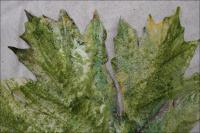 Encaustics tecniques, see right sample. Beeswax doesn’t adhere to acrylics though, so another will need to be planned with that medium in mind right from the start.
Encaustics tecniques, see right sample. Beeswax doesn’t adhere to acrylics though, so another will need to be planned with that medium in mind right from the start.
Kookaburrahs
Saturday, May 23rd, 2009
Kookaburras, 11H x 11W x 3D inches acrylics on canvas, wrapped sides painted. Frame unnecessary. Hang on the wall or display on a flat surface. Most of the Magic Square series are signed on the side so as not to impose on the composition. Seen here, the signature is added digitally on the front.
March 13th, 2009 work progress blog post: This painting could have been left at phase 3, but the decision to give the birds more definition and sense of realism created a whole new set of problems. For example, the composition, which was unbalanced from the start, is now exaggerated and more noticeable, so a third element needs to be added in the upper left corner. Not necessarily another object but color or shape that would shift the weight and attention away from the lower left areas.
| Progress details: | |||
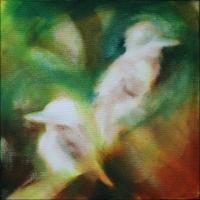 |
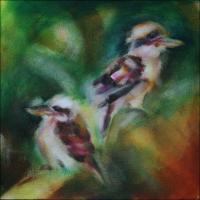 |
||
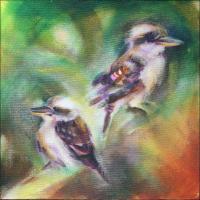 |
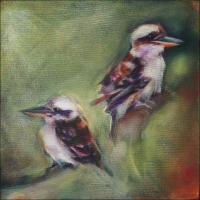 |
||
There is a work phase where, once details are added or changes made to one area, every other thing in the picture needs to be brought to the same level of quality: quality meaning style and feeling of the features. I don’t regret proceeding, but it does mean extra effort to solve all the new challenges, and usually while attempting to solve those new ones arise. Other professionals would say this is overworking, but it really depends on what your intentions are as an Artist, and what motivates the work. If risks are not taken sometimes, a painting may never be all that it could be. Phrases we tend to cling to like “less is more” are not written in stone; sometimes more is more…learning is a good thing!
In landscapes details are best left for the imagination, whereas painting animals, birds or other creatures, a purpose needs to be clearer. Is the intention to portray character through shape and silhouette? other traits? specific markings? Is it the main focus or only a part of the whole? Computer tools are also useful in playing with colors and other possibilities.
Sumac Bushes Chair finished
Tuesday, May 5th, 2009
Sumac Bushes, 47H x 22W x 16D inches refurbished Director’s Chair, acrylics on canvas.
Four cropped pieces of the 1999 painting that inspired this chair hang above it, updated and framed with red narrow plastic w/glass frames. The chair and small paintings are a set.
Interactive
Saturday, April 25th, 2009
At the end of each month Oxide Gallery and Carino’s Italian Restaurant in Denton present an evening of Art, Dinner and Wine Tasting. Offering a new menu each month, an amazing four course dinner is complete with wine pairings for only $29.95. The room is separate from the rest of the restaurant, so offers an intimate setting where, at some point during the evening, the artist discusses and answers questions about their work. A new artist’s work is featured each month, and on Tuesday it’s my turn. Although this is a new idea it has been well received. Reservations are required, but April 28th is now booked solid, so the Dinner and Show is extended to take place on April 29th as well.
The Interaction with Flowering Shavingbrush Tree
I reapplied masking fluid to the painting in order to continue working on it but still preserve all the great marks revealed after removing the first application. At Carino’s on Tuesday others will participate and be a part of helping this painting come to life by removing the dried rubberized medium from the painting, and help unveil the finished piece.
Update, May 1st: Pulling off the rubberized medium was a hit! A few people kept going back to pull more off. If gallery owners are open to it, I’d like to continue doing this at future opening receptions too. Here are some photos of the fun.
“One last peel before I go…”
The Tree Of Life chair
Saturday, April 18th, 2009
April 18th, above: still in an extremely rough state, and still deciding about which colors to use and how. There must be much more plaster on the Salish chair, because this one is not carving as well. Only the Shou symbol will stand out carved..all else will be implied. Blue, purple and green are the new black! Actually that’s the old impressionist trick of course, but I also rarely use black if those 3 will do – they are much livelier and more interesting than flat black. The Yin-Yang/Aboriginal legend snakes have been eliminated because working them in color-wise was going to be a problem. The Celtic design was getting lost in too much else around it. I am anxious to find another chair because I really want to do one with Australian-inspired motifs and colors.
Post-dated note: Unfortunately, there is not enough room to show this for the premier of the Trees show in Raleigh. I’m mostly relieved that there is extra time in my schedule now for preparations, but this chair now needs to be set aside in light of the other priorities.
April 14th: 29H x 29W x 29D inches vintage chair, canvas strips, layers of sanded plaster.
The design incorporates a few esoteric concepts common to many world cultures: Overall is the idea of the Tree of Life and the theory of As above, So below, represented by branches and roots. Symbolic of longevity along with the pine tree, and central to the design is the Japanese character, Shou. The branches and roots of the pine tree are interwoven in the classic Celtic style, inspired by designs in the Book of Kells, gospel manuscripts that were illustrated by Irish monks around the year 800 A.D., common era. Two snakes drawn in the Yin-Yang placement represent Australian Aboriginal legends; the Rainbow Snake is their most important sacred symbol, believed to be the creator of all things. Christian biblical literature it is the snake who gives the apple from the Tree of Knowledge to Eve. There are more, but the rest you may like to discover yourself!
There is still plenty of intricate work to do with the roots – this’ll be fun! Drawing freehand is much better than casting the original drawing on with light and tracing it because each time it’s drawn, first with graphite, then marker, then many layers of paint, I become more familiar with the lines and the final outline will be steady and clean.
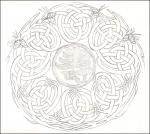 April 7, 2009: While studying some of the previous paintings that are still in progress, I sketched out my version of The Tree of Life, a preliminary drawing for the fourth refurbished vintage chair, and have also been layering and sanding the plaster in preparation for it. Colors planned are black, off-white and greens. The other chairs in this series are shown here.
April 7, 2009: While studying some of the previous paintings that are still in progress, I sketched out my version of The Tree of Life, a preliminary drawing for the fourth refurbished vintage chair, and have also been layering and sanding the plaster in preparation for it. Colors planned are black, off-white and greens. The other chairs in this series are shown here.
The perfect place for masking fluid
Monday, April 13th, 2009
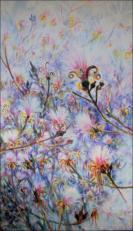 Flowering Shavingbrush Tree, April 11th above: details of 85H x 45W x 3D inches acrylics on canvas,wrapped sides painted, trim frame. Still in progress, but the rubberized mask was removed in order to see exactly what stage things are at before continuing. The painting overall still has a few areas to open up; very little work tomorrow should finish it. Shortly after starting the painting I turned it upside down and applied the masking fluid with a toothpick and let it drip. Gravity can be used as a tool!
Flowering Shavingbrush Tree, April 11th above: details of 85H x 45W x 3D inches acrylics on canvas,wrapped sides painted, trim frame. Still in progress, but the rubberized mask was removed in order to see exactly what stage things are at before continuing. The painting overall still has a few areas to open up; very little work tomorrow should finish it. Shortly after starting the painting I turned it upside down and applied the masking fluid with a toothpick and let it drip. Gravity can be used as a tool!
April 13th, Left: The top third will still leave as much of the primed canvas as possible; a gradation of unfinished space toward more finished at the bottom. I was hoping to leave it as seen here giving an airy illusion, but it does need to develop along with the rest of it…still not as much, but enough to show the main flower better. This means I’ll be once again dripping masking fluid on the piece upside down to preserve the interesting marks that occurred from the 1st application, and also create some new ones with any further work. For previous posts on earliest progress of this painting click here.
Eastern Redbuds
Saturday, April 11th, 2009
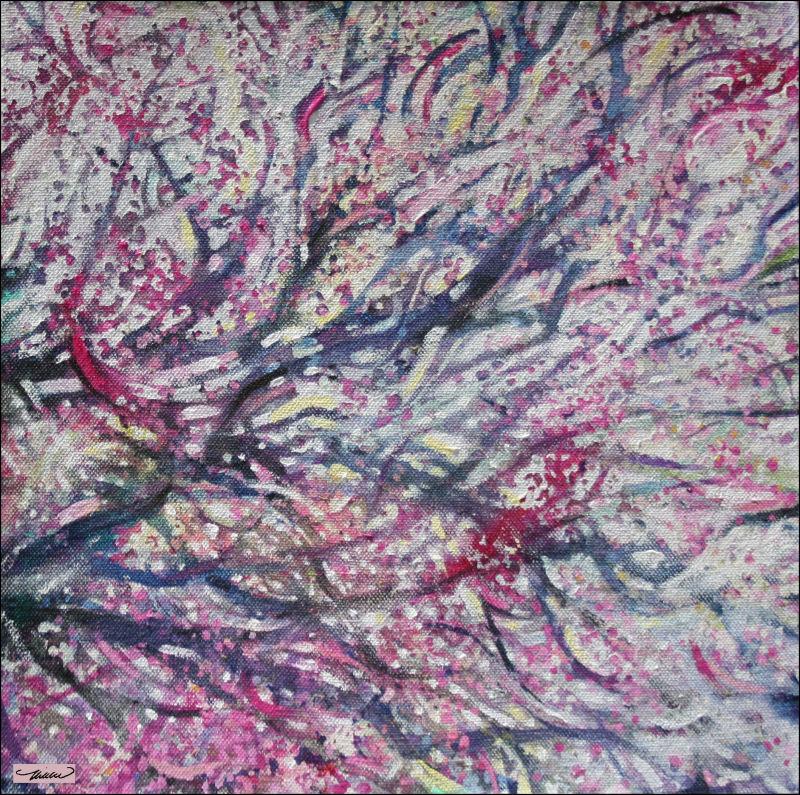
Eastern Redbuds – Spring in Dallas, TX – finished April 11, 2009, took off all remaining masking fluid. 11H x 11W x 3D inches, acrylics on canvas, wrapped sides painted. Signature is on the side, so one is superimposed here on the front. Hang on a wall or display on a flat surface.
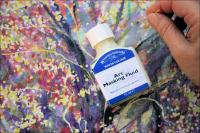 Eastern Redbuds is the first of sixteen 11H x 11W x 3D inches acrylics on canvas paintings of various aspects of trees, to hang together as a group or flanking other paintings. This one uses masking medium to block out areas of white. The first layer of dried medium was removed in the above thumbnails. Afternoon post, left: Adding another layer of masking fluid, seen as yellow.
Eastern Redbuds is the first of sixteen 11H x 11W x 3D inches acrylics on canvas paintings of various aspects of trees, to hang together as a group or flanking other paintings. This one uses masking medium to block out areas of white. The first layer of dried medium was removed in the above thumbnails. Afternoon post, left: Adding another layer of masking fluid, seen as yellow.
Feb. 25th: below left, looks better turned on its side but it could be hung either direction, mask was removed then the painting was overworked unintentionally – all the marks that were the whole point of using masking fluid are hardly visible.
So on Feb. 26th: below right, more mask was applied, then white painted between branches, tore away a few select areas of the dried mask and left the rest on as texture.
« Previous Entries


